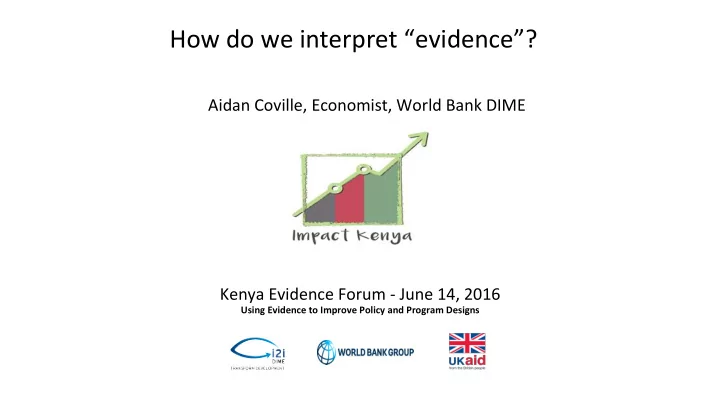

How do we interpret “evidence”? Aidan Coville, Economist, World Bank DIME Kenya Evidence Forum - June 14, 2016 Using Evidence to Improve Policy and Program Designs
Impact of sewerage connec0ons? diarrhea 25% Sewerage connecPons 20% in an informal seQlement 20% Impact? 15% 12% 10% 5% 0% Before AMer
Is this the impact of providing sewerage? A. YES 65% B. NO 35% YES NO
Impact of DIME Nigeria GDP (USD Billions) 600 DIME started 509 working with 500 Nigerian Ministry of 400 Health 300 260 200 100 0 2012 2013
Is this the impact of DIME? A. YES 76% B. NO 24% YES NO
Monitoring vs. impact evalua0on Monitoring Impact EvaluaPon • Collects data on treatment • Assigns intervenPon to treatment groups to: and control groups to: • Track performance over Pme • Measure counterfactual: what would have happened? • Tell us whether we’re moving in the right direcPon • Establish causal link between intervenPon and outcome • Describes what is happening, but not why or whether this is • So we can measure impact of because of our intervenPon policy, compare instruments, make beQer decisions and improve policy over Pme
The Value of a Control Group Control Group Treatment Group 14 12 (+) Impact of the program?? 10 (+) Impact of other (external) factors 8 6 4 2 0 Before AMer
The Value of a Control Group Control Group Treatment Group 14 (+) Impact of the 12 program 10 (+) Impact of other (external) factors 8 6 4 2 0 Before AMer
Counterfactual criteria Treated & comparison groups • Have idenPcal iniPal average characterisPcs (observed and unobserved) • The only difference is the treatment • Therefore the only reason for the difference in outcomes is due to the treatment • We generate these equal groups through randomized allocaCon: on average control and treatment groups are the same
The produc0on of useful research It needs to be rigorous and relevant It needs to be used
Tablet Ques0onnaire • How can we produce evidence to more effecPvely inform policy? • What are your beliefs about the effecPveness of parPcular intervenPons? • What aQributes of a study do think make the study most useful/ relevant?
Imagine a rouleCe table
Now to make it simpler let’s imagine it has 100 numbers… (apparently this really exists…)
Ques0on: what number do we think it will land on?
In this case all numbers are equally likely between 1 and 100
For each choice we make, we can es0mate the chances / probability that the actual number lands below or above our choice
If we choose “75”, what is the probability that a number higher than 75 will come up?
What If we choose “50”? There is a 50% probability that a number higher than 50 will come up.
Finally, let’s try 25… what is the probability of a larger number being drawn?
You’ve just had the stats course you always wanted to avoid in university! • The rouleQe example describes percenCles • The median or 50 th percenCle is the number where the true result has a 50% chance of being above or below that number • The 75 th percenPle is the number where the true result has a 25% chance of being above or a 75% chance of being below that number • And… • The 25 th percenPle is the number where the true result has a 75% chance of being above or a 75% chance of being below that number • And so on…
Es0ma0ng a program impact • In reality, we make esPmates (or best guesses) all the Pme… • While gambling is pure luck, our esPmates are based on informed guesses using our available knowledge. • Let’s take a shot at esPmaPng the impact of a program: • Later you will learn about the impact of providing subsidies to rural households to connect to the electricity grid in Kenya. • Let’s guess what the impact will be of reducing the cost of connecPon from 35,000 to KSh 25,000 ?
Median (50 th th p Median (50 per ercen cen0le): le): What is your median es0mate of the program impact (the number where you think its equally likely to have been a larger or smaller impact)? 39% A. 10% connected B. 20% connected 26% C. 30% connected D. 40% connected 10% 10% 10% E. 50% connected 3% 3% F. 60% connected 10% connected 20% connected 30% connected 40% connected 50% connected 60% connected 70% connected G. 70% connected
75 th th p What is your es0mate of the 75 per ercen cen0le le of the program impact (the number where you think there’s a 25% chance that the TRUE impact is bigger and a 75% chance it is a smaller impact)? 23% A. 10% connected 17% 17% B. 20% connected 13% 13% C. 30% connected 10% D. 40% connected 7% E. 50% connected F. 60% connected 10% connected 20% connected 30% connected 40% connected 50% connected 60% connected 70% connected G. 70% connected
25 th th p What is your es0mate of the 25 per ercen cen0le le of the program impact (the number where you think there’s a 75% chance that the TRUE impact is bigger and a 25% chance it is a smaller impact)? 27% A. 10% connected 21% B. 20% connected 15% C. 30% connected 12% 9% 9% D. 40% connected 6% E. 50% connected F. 60% connected 10% connected 20% connected 30% connected 40% connected 50% connected 60% connected 70% connected G. 70% connected
Now you’re ready to take this on your own… ONLINE OPTION: hQp://bit.ly/1UMOkME Note the capital and small leQers
Recommend
More recommend